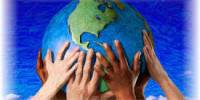About Bangladesh
“Bangladesh” is a combination of the Bengali words, Bangla and Desh, meaning the country or land where the Bangla language is spoken. The country formerly was known as East Pakistan.
Bangladesh is the most densely populated nation in the world. With approximately 125 million inhabitants living in an area of 55,813 square miles, there are about 2,240 persons per square mile. The majority of the population (98 percent) is Bengali, with 2 percent belonging to tribal or other non-Bengali groups. Approximately 83 percent of the population is Muslim, 16 percent is Hindu, and 1 percent is Buddhist, Christian, or other. Annual population growth rate is at about 2 percent.
The most important symbol of national identity is the Bangla language. The flag is a dark green rectangle with a red circle just left of center. Green symbolizes the trees and fields of the countryside; red represents the rising sun and the blood spilled in the 1971 war for liberation. The national anthem was taken from a poem by Nobel laureate Rabindranath Tagore and links a love of the natural realm and land with the national identity.
Since independence in 1971, the national identity has evolved. Islamic religious identity has become an increasingly important element in the national dialogue. Many Islamic holy days are nationally celebrated, and Islam pervades public space and the media.
Religion
Religious Beliefs: The symbols and sounds of Islam, such as the call to prayer, punctuate daily life. Bangladeshis conceptualize themselves and others fundamentally through their religious heritage. For example, the nationality of foreigners is considered secondary to their religious identity.
Islam is a part of everyday life in all parts of the country, and nearly every village has at least a small mosque and an imam (cleric). Prayer is supposed to be performed five times daily, but only the committed uphold that standard. Friday afternoon prayer is often the only time that mosques become crowded.
Throughout the country there is a belief in spirits that inhabit natural spaces such as trees, hollows, and riverbanks. These beliefs are derided by Islamic religious authorities.
Hinduism encompasses an array of deities, including Krishna, Ram, Durga, Kali, and Ganesh. Bangladeshi Hindus pay particular attention to the female goddess Durga, and rituals devoted to her are among the most widely celebrated.
Religious Practitioners: The imam is associated with a mosque and is an important person in both rural and urban society, leading a group of followers. The imam’s power is based on his knowledge of the Koran and memorization of phrases in Arabic. Relatively few imams understand Arabic in the spoken or written form. An imam’s power is based on his ability to persuade groups of men to act in conjunction with Islamic rules. In many villages the imam is believed to have access to the supernatural, with the ability to write charms that protect individuals from evil spirits, imbue liquids with holy healing properties, or ward off or reverse of bad luck.
Brahman priests perform rituals for the Hindu community during the major festivals when offerings are made but also in daily acts of worship. They are respected, but Hinduism does not have the codified hierarchical structure of Islam. Thus, a Brahman priest may not have a position of leadership outside his religious duties.
Rituals and Holy Places: The primary Islamic holidays in Bangladesh include: Eid-ul-Azha (the tenth day of the Muslim month Zilhaj ), in which a goat or cow is sacrificed in honor of Allah; Shob-i-Barat (the fourteenth or fifteenth day of Shaban ), when Allah records an individual’s future for the rest of the year; Ramadan (the month Ramzan ), a month-long period of fasting between dawn and dusk; Eid-ul-Fitr (the first day of the month Shawal, following the end of Ramzan ), characterized by alms giving to the poor; and Shob-i-Meraz (the twenty-seventh day of Rajab ), which commemorates the night when Mohammed ascended to heaven. Islamic holidays are publicly celebrated in afternoon prayers at mosques and outdoor open areas, where many men assemble and move through their prayers in unison.
Among the most important Hindu celebrations are Saraswati Puja (February), dedicated to the deity Saraswati, who takes the form of a swan. She is the patron of learning, and propitiating her is important for students. Durga Puja (October) pays homage to the female warrior goddess Durga, who has ten arms, carries a sword, and rides a lion. After a nine-day festival, images of Durga and her associates are placed in a procession and set into a river. Kali Puja (November) is also called the Festival of Lights and honors Kali, a female deity who has the power to give and take away life. Candles are lit in and around homes.
Cultural Festivals
Ekushee (21 February), also called Shaheed Dibash, is the National Day of Martyrs commemorating those who died defending the Bangla language in 1952. Political speeches are held, and a memorial service takes place at the Shaheed Minar (Martyr’s Monument) in Dhaka. Shadheenata Dibash, or Independence Day (26 March), marks the day when Bangladesh declared itself separate from Pakistan. The event is marked with military parades and political speeches. Poila Boishakh, the Bengali New Year, is celebrated on the first day of the month of Boishakh (generally in April). Poetry readings and musical events take place. May Day (1 May) celebrates labor and workers with speeches and cultural events. Bijoy Dibosh, or Victory Day (16 December), commemorates the day in 1971 when Pakistani forces surrendered to a joint Bangladeshi–Indian force. Cultural and political events are held.

Etiquette
Personal interaction is initiated with the greeting Assalam Waleykum (“peace be with you”), to which the required response is, Waleykum Assalam (“and with you”). Among Hindus, the correct greeting is Nomoshkar, as the hands are brought together under the chin. Men may shake hands if they are of equal status but do not grasp hands firmly. Respect is expressed after a handshake by placing the right hand over the heart. Men and women do not shake hands with each other. In same-sex conversation, touching is common and individuals may stand or sit very close. The closer individuals are in terms of status, the closer their spatial interaction is. Leave-taking is sealed with the phrase Khoda Hafez.
Differences in age and status are marked through language conventions. Individuals with higher status are not addressed by personal name; instead, a title or kinship term is used.
Visitors are always asked to sit, and if no chairs are available, a low stool or a bamboo mat is provided. It is considered improper for a visitor to sit on the floor or ground. It is incumbent on the host to offer guests something to eat.
In crowded public places that provide services, such as train stations, the post office, or bazaars, queuing is not practiced and receiving service is dependent on pushing and maintaining one’s place within the throng. Open staring is not considered impolite.
Food and Economy
Food in Daily Life:
Rice and fish are the foundation of the diet; a day without a meal with rice is nearly inconceivable. Fish, meats, poultry, and vegetables are cooked in spicy curry ( torkari ) sauces that incorporate cumin, coriander, cloves, cinnamon, garlic, and other spices. Muslims do not consume pork and Hindus do not consume beef. Increasingly common is the preparation of ruti, a whole wheat circular flatbread, in the morning, which is eaten with curries from the night before. Also important to the diet is dal, a thin soup based on ground lentils, chickpeas, or other legumes that is poured over rice. A sweet homemade yogurt commonly finishes a meal. A typical meal consists of a large bowl of rice to which is added small portions of fish and vegetable curries. Breakfast is the meal that varies the most, being rice- or bread-based. A favorite breakfast dish is panthabhat, leftover cold rice in water or milk mixed with gur (date palm sugar). Food is eaten with the right hand by mixing the curry into the rice and then gathering portions with the fingertips. In city restaurants that cater to foreigners, people may use silverware.
Three meals are consumed daily. Water is the most common beverage. Before the meal, the right hand is washed with water above the eating bowl. With the clean knuckles of the right hand the interior of the bowl is rubbed, the water is discarded, and the bowl is filled with food. After the meal, one washes the right hand again, holding it over the emptied bowl.
Snacks include fruits such as banana, mango, and jackfruit, as well as puffed rice and small fried food items. For many men, especially in urbanized regions and bazaars, no day is complete without a cup of sweet tea with milk at a small tea stall, sometimes accompanied by confections.
Basic Economy:
With a per capita gross national product (GNP) of $350 and an overall GNP of $44 billion, Bangladesh is one of the poorest countries in the world. The only significant natural resource is natural gas.
Approximately 75 percent of the workforce is involved in agriculture, and 15 percent and 10 percent are employed in the service and industrial sectors, respectively. Bangladesh has been characterized as a nation of small, subsistence-based farmers, and nearly all people in rural areas are involved in the production or processing of agricultural goods. The majority of the rural population engages in agricultural production, primarily of rice, jute, pulses, wheat, and some vegetables. Virtually all agricultural output is consumed within the country, and grain must be imported. The large population places heavy demands on the food-producing sectors of the economy. The majority of the labor involved in food production is human- and animal-based. Relatively little agricultural export takes place.

Conclusion
Bangladesh has a history. The land, the rivers and the lives of the common people formed a rich heritage with marked differences from neighbouring regions. It has evolved over the centuries and encompasses the cultural diversity of several social groups of Bangladesh. The culture of Bangladesh is best among the best. So we r really happy to b a Bangladeshi.
















